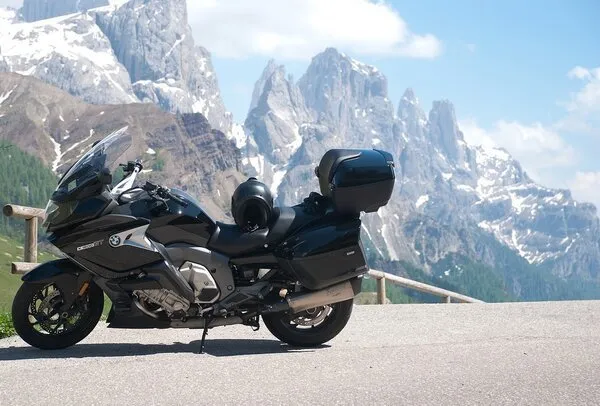You’ve just started looking up local campsites and want to travel long distances to stargaze. But you’re unable to find the right bike for it. Here’s how to choose a touring motorcycle for your next tour?
First things first, do you even need a touring bike? You could just take your regular bike or scooter, and it would do the trick, right? Well, if you’re going to be carrying a lot of luggage, such as camping materials or your clothes, then you’ll need a bike that can handle all that weight.
Touring bikes have a higher weight threshold with dedicated luggage compartments. Weight impacts fuel economy and ride stability, so being fitted with a stronger engine is a bonus.
Let’s find out how to choose a touring motorcycle from the overwhelming options available on the market.
How to Choose A Touring Motorcycle?
Are You Planning to Stay in A Hotel or Camp?

The first thing to consider is whether you’ll be staying in a hotel or a camp. This is because, if your tour includes camping, you’ll need a bike with a lot of luggage capacity. Some tours are short-lived and don’t require accommodation. But others may call for setting up campsites.
One thing, in particular, to look for in such touring bikes is the ability to hook down or strap some objects such as flashlights and water bottles. More the storage space you have, the better.
Reliability:
Reliability is a basic requirement on any bike. But on touring motorcycles, it becomes an even more dire need. Imagine you’re all alone on a long stretch of road, and suddenly your bike breaks down. That’s not the best scenario.
You want a bike that will last for a long. Look for aspects like a long-range, a place to store extra fuel, durable construction, and good user reviews. The reliability of your bike will go down if it’s used, but you can still have a professional take a look at it and refurbish it.
As for new bikes, only buy from brands that have a good reputation. And if possible, buy from the original manufacturer or verified retailers.
Length of Trip:
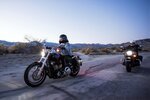
The average length of your trips will heavily impact your buying decision. Longer trips will require a longer range, more gas mileage, more durability, and a place to store more goods. Since you’ll be riding for a long time, you’ll also want the ride to be more comfortable. See our section below on comfort for more details.
Bikes have a limited range on max fuel. If you want to drive longer, you should consider going somewhere where you’ll have access to fueling stations. And remember to factor in return time as well.
Type of Roads:
The type of road you’ll be driving on is the most important consideration when choosing a touring bike. Not every road will even require a touring bike. If you’re driving on roads that run straight for a good length of the way, such as interstate highways, then you can make do it with a touring bike.
However, the road is a bit more convoluted, considering dual sports bikes that have at least a 650-cc engine. Some bikes that are combinations of sports and touring bikes can also be ridden here.
If the road is unpaved, you’ll most definitely need a dual sports bike. A regular touring bike simply won’t make it. It will have lower mileage and a worse fuel economy.
There are some other considerations as well. You’ll need a better, smoother suspension if the road is too bumpy. If it’s hilly, you’ll need a lot of fuel capacity. And if it’s wet or snowy, you’ll need special all-weather tires as well as fuel that won’t freeze up.
Solo Trip or Two Up:
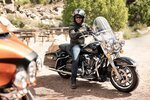
Consider whether you’re going to ride with a pillion or solo. Bikes for solo rides are smaller and focus more on luggage space, whereas bikes for pillion riding are longer and may compromise luggage space. Additionally, bikes meant for pillion riding have a higher weight threshold than solo bikes. Even if your bike has some space behind it, seating a pillion may overburden the engine. Be sure to only buy touring bikes that are meant for pillion riding.
Fuel Efficiency:
Fuel efficiency, also called gas mileage, is an important aspect of choosing the right touring bike. Fuel is the most important resource when you have to travel long distances without any refueling stations nearby. So naturally, you’d want your bike to use its fuel as efficiently as it can.
Many things can influence the fuel economy, such as your weight, braking efficiency, idling habits, and smoothness of the path. Aside from these, your bike’s inherent qualities will also affect fuel economy. Consider a bike with an engine that’s made to withstand heavyweight. Some bikes may mark off their weight threshold at a certain point, but this threshold may not be the most fuel-efficient one.
Riding Range Before Refueling:
Aside from the trip’s length, consider the riding range of the bike before you’ll need to refuel. This is important as you may not be around any refueling stations for a while. So you’ll need a bike that has a longer range.
Remember that most ranges mentioned on the bike’s product page are measured without any additional weights. As discussed earlier, a lot of things can influence your bike’s fuel economy.
Type of Luggage and Carrying Capacity:
Most touring bikes are made to carry a lot of luggage. Since you’ll carry a lot of weight with you, it’s important to consider the bike’s carrying capacity. One quick trick for calculating the total carrying capacity is by subtracting the wet weight from the GVWR.
This will give you the carrying capacity of the bike. To calculate how much capacity you need, add your weight (and your pillion’s, if any), your riding gear’s weight, and the weight of your luggage. The capacity you need should match the capacity of the bike.
Comfort:
Since you’re going to be driving for a long time, comfort is an exceptionally useful quality when considering choosing a touring motorcycle. Here’s how you can estimate the comfort of your bike:
Wind Protection:
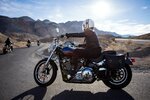
Wind protection is more important than you think. Going against the wind reduces your fuel’s efficiency and may require you to exert more force on the brakes or accelerator. And if it’s too cold outside, too much wind can cause hypothermia.
Luckily, even if your bike doesn’t come with adequate wind protection, some modification shops will do it for you.
Suspension:
No one likes a long bumpy ride. Suspension is the most basic requirement for any comfortable trip. However, since each rider weighs differently and has a different riding style, it’s highly recommended to adjust your suspension.
Buying a bike with adjustable suspension is always a major plus point. But even if your suspension isn’t adjustable, you can swap it out for an adjustable one.
Seating Position:
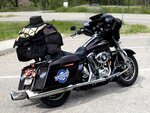
Many people think that the seating position isn’t very relevant. But sit for two hours in an uncomfortable position, and you’ll soon wish you had made a better decision. The seating position is crucial to your spine’s health and comfort. The best seating position for tourists is leaning forward with the feet right under the thighs.
For better cornering comfort, you’ll want handlebars that are right below your triple clamp. Do not buy tourist bikes that feature a laid-back seating position. This will cause immense strain and discomfort and will put pressure on your tailbone.
Seating Support:
Aside from the seating position, also take a look at the seat itself. Many manufactures don’t provide a supportive seat. You’ll want a seat that, at its core, is strong enough to hold your weight but at the surface isn’t too hard.
Luckily, if your current seat isn’t the right one, you can swap it out for a better aftermarket seat. Or you can make your seat with little to no adversities.
Sportiness:
Sportiness isn’t a trait common to touring bikes. It’s mainly considered a luxury. But sportiness can be found in the performance of the bike as well. And on some touring bikes, sportiness is preferred.
You can buy some dual-sport or sporty touring bikes that have decent carrying capacity along with a higher top speed. However, the more sporty the bike is, the less optimized it is for tourism. Sporty bikes compromise on weight, carrying capacity, fuel economy, and stability.
What Are the Best Motorbikes for Touring?
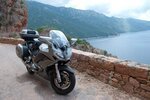
Now you know how to choose a touring motorcycle. So what are the best ones? The single best motorbike for touring would have to be the Harley-Davidson Electra Glide 2021. That’s partly due to the brand’s reliability and partly due to the performance of the bike. It has a 1746 cc V-twin engine that can doesn’t feel like a drag during longer trips.
Running up close to that is the Kawasaki Concours 14, which is a sport-touring bike. It has one of the best aerodynamic I have seen. And its handling isn’t short of smooth. However, it lacks cruise control, which is going to disappoint hardcore tourists.
For a touring motorcycle that can seat two people, consider BMW R1250RT. It’s lightweight and equipped with a powerful 1170 cc engine. Moreover, it has semi-active suspension and remote locking luggage, perfect for most tourists.
Top 7 Tips for Riding A Touring Motorcycle:
Aside from knowing how to choose a touring motorcycle, here are 7 essential tips for touring:
Be Mindful of Weight Transfers:
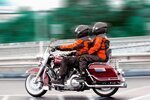
A motorcycle is a motorized bike, which means balance is everything. With a touring bike, you’re going to be carrying a lot of luggage that will shift your weight. Try equally dividing your luggage (in weight) across both sides to minimize any weight imbalances.
However, even if you do that, you can very easily be thrown off balance when braking or accelerating. Be mindful of any major weight transfers. When you break, your weight will be shifted forward. To minimize this weight transfer, hit the front and rear brakes both at the same time.
Find Your Center of Gravity:

The center of gravity is essential for maintaining stable equilibrium. If your center of gravity is near the top of the bike, for example, even the slightest nudge to either side will throw your balance off. Most touring bikes have a low center of gravity. But once packed with luggage and pillion, the center of gravity will drastically shift.
Keep Checking on Your Luggage:
You don’t want to drive for hours on end only to realize you forgot to clasp the luggage down. If the luggage includes lightweight items like clothes and jewelry, they could very easily fly away. Keep checking on your luggage whenever you make a stop, and ensure that the locks are fastened. You may assign this task to your pillion, as it will be easier for them.
Stay Focused:
The road is full of distractions. And this time, you’re carrying a lot more weight than usual. Staying focused is crucial for a safe long drive.
At this stage, it is important to understand that not all distractions are present on the road. Some of them may be in your bike as well, such as flashing lights and indicators. Understand the dangers of getting distracted with a touring bike and do the smart thing: stay focused.
Have an Informed Pillion:
Managing weight shifts and remaining balanced isn’t just something the driver should do. You should inform your pillion about how to get seated right. Always wait for your partner to find their right balance and sit comfortably.
Also, ask them to not distract you too much with casual banter and unnecessary directions.
Test Your Bike Beforehand:
It’s a good idea to test your bike before you take off on your tour. After all, it would be highly inefficient if your bike breaks down during the trip. Check for balance, the center of gravity with the luggage on, turning resistance, and fuel economy.
It’s Just A Bike, Relax:
Lastly, remember to relax. It’s just a bike. Driving a touring bike is no different than driving any other bike. Do not be fazed by the extra weight, as long as you have the right engine to overcome it. But it’s still important to note certain hazards and avoid risky situations.
Conclusion
Touring bikes add a lot of fun and convenience to your tour. But since many can be costly, going into the showroom uninformed can be risky.
Above were just a few of the factors to keep in mind when buying a touring motorcycle. It can be pretty challenging to pick out the right one. But once you’ve covered that phase, the journey ahead becomes a lot easier.
Now you know how to choose a touring motorcycle! They may certainly look like regular bikes with luggage space, but there’s a lot more to them. So go and discover the differences for yourself!

